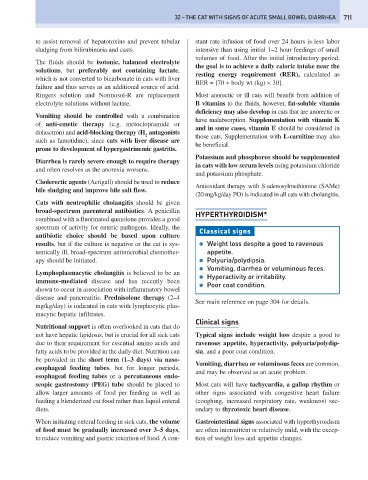Page 719 - Problem-Based Feline Medicine
P. 719
32 – THE CAT WITH SIGNS OF ACUTE SMALL BOWEL DIARRHEA 711
to assist removal of hepatotoxins and prevent tubular stant rate infusion of food over 24 hours is less labor
sludging from bilirubinuria and casts. intensive than using initial 1–2 hour feedings of small
volumes of food. After the initial introductory period,
The fluids should be isotonic, balanced electrolyte
the goal is to achieve a daily caloric intake near the
solutions, but preferably not containing lactate,
resting energy requirement (RER), calculated as
which is not converted to bicarbonate in cats with liver
BER = [70 + body wt (kg) × 30].
failure and thus serves as an additional source of acid.
Ringers solution and Normosol-R are replacement Most anorectic or ill cats will benefit from addition of
electrolyte solutions without lactate. B vitamins to the fluids, however, fat-soluble vitamin
deficiency may also develop in cats that are anorectic or
Vomiting should be controlled with a combination
have malabsorption. Supplementation with vitamin K
of anti-emetic therapy (e.g. metoclopramide or
and in some cases, vitamin E should be considered in
dolasetron) and acid-blocking therapy (H antagonists
2 those cats. Supplementation with L-carnitine may also
such as famotidine), since cats with liver disease are
be beneficial.
prone to development of hypergastrinemic gastritis.
Potassium and phosphorus should be supplemented
Diarrhea is rarely severe enough to require therapy
in cats with low serum levels using potassium chloride
and often resolves as the anorexia worsens.
and potassium phosphate.
Cholerectic agents (Actigall) should be used to reduce
Antioxidant therapy with S-adenosylmethionine (SAMe)
bile sludging and improve bile salt flow.
(20 mg/kg/day PO) is indicated in all cats with cholangitis.
Cats with neutrophilic cholangitis should be given
broad-spectrum parenteral antibiotics. A penicillin
HYPERTHYROIDISM*
combined with a fluorinated quinolone provides a good
spectrum of activity for enteric pathogens. Ideally, the
Classical signs
antibiotic choice should be based upon culture
results, but if the culture is negative or the cat is sys- ● Weight loss despite a good to ravenous
temically ill, broad-spectrum antimicrobial chemother- appetite.
apy should be initiated. ● Polyuria/polydipsia.
● Vomiting, diarrhea or voluminous feces.
Lymphoplasmacytic cholangitis is believed to be an
● Hyperactivity or irritability.
immune-mediated disease and has recently been
● Poor coat condition.
shown to occur in association with inflammatory bowel
disease and pancreatitis. Prednisolone therapy (2–4
See main reference on page 304 for details.
mg/kg/day) is indicated in cats with lymphocytic plas-
macytic hepatic infiltrates.
Clinical signs
Nutritional support is often overlooked in cats that do
not have hepatic lipidosis, but is crucial for all sick cats Typical signs include weight loss despite a good to
due to their requirement for essential amino acids and ravenous appetite, hyperactivity, polyuria/polydip-
fatty acids to be provided in the daily diet. Nutrition can sia, and a poor coat condition.
be provided in the short term (1–3 days) via naso-
Vomiting, diarrhea or voluminous feces are common,
esophageal feeding tubes, but for longer periods,
and may be observed as an acute problem.
esophageal feeding tubes or a percutaneous endo-
scopic gastrostomy (PEG) tube should be placed to Most cats will have tachycardia, a gallop rhythm or
allow larger amounts of food per feeding as well as other signs associated with congestive heart failure
feeding a blenderized cat food rather than liquid enteral (coughing, increased respiratory rate, weakness) sec-
diets. ondary to thyrotoxic heart disease.
When initiating enteral feeding in sick cats, the volume Gastrointestinal signs associated with hyperthyroidism
of food must be gradually increased over 3–5 days, are often intermittent or relatively mild, with the excep-
to reduce vomiting and gastric retention of food. A con- tion of weight loss and appetite changes.

